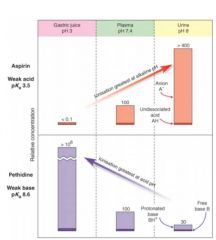![]()
![]()
![]()
Use LEFT and RIGHT arrow keys to navigate between flashcards;
Use UP and DOWN arrow keys to flip the card;
H to show hint;
A reads text to speech;
29 Cards in this Set
- Front
- Back
|
What is Lipinski's rule of 5? |
Drug absorption of a molecule is poor if: - More than 5 H-bond donors - More than 10 H-bond acceptors - Molecular weight>500 - LogP>5 |
|
|
What is permeability dependent upon? |
-Solubility in membrane lipid -Mobility in membrane lipid -Molecular mass |
|
|
Which type of drugs is usually more soluble, polar or non-polar? |
Polar- charge promotes solvation by water. (Water is polar, and like dissolves like). |
|
|
What type of drugs are transported across membranes via paracellular diffusion? |
Small (Mr<350) polar drugs |
|
|
What is Fick's Law? |

|
|
|
Which molecular shape leads to poor absorption, and why? |
Planar. The flat drug molecules stack up against each other, making them less soluble than irregular shaped drugs, |
|
|
What is the definition of flux? |
How many drug molecules are moving across the membrane per unit time. |
|
|
What type of drugs have a high membrane permeability? |
Lipophilic. Like dissolves like. |
|
|
Why is there a 'conflict' with drugs diffusing through the lipid bilayer? |
Drugs need to be hydrophilic and polar to dissolve in water, however they must also be lipophilic and uncharged to allow them to permeate the membrane. |
|
|
What's the equation for the Maximum Absorbable Dose? |

Whereby: S= solubility Ka= Rate constant for absorption across membrane tsi= transit time through SI Vsi= volume of SI |
|
|
pH Trapping |

|
|
|
Henderson-Hasselbalch Equations |

|
|
|
What is the biliary tract? |
The organs and ducts that make and store bile. |
|
|
What is carrier-mediated transport important for? |
Drug movement across: -BBB -GI Tract -Renal Tubule -Biliary Tract -Placenta |
|
|
What factors affect GI Absorption? |
-Anatomical Factors (Stomach, SI, LI) -pH -Permeability and Solubility -Binding to other material in GI tract -Gastric Emptying -Metabolism -Efflux Pumps in Membrane |
|
|
Which types of molecules are prone to hydrolysis? |
Amides and Esters |
|
|
What does cholestyramine do? |
Treats elevated plasma cholesterol levels. |
|
|
Why might it be useful to take a drug with food? (In terms of absorption) |
If a drug is poorly absorbed, it will need to be taken with food. If it's taken with food, it will delay gastric emptying, so the drug will already be dissolved when it leaves via the pyloric sphincter. The drug can then go straight into the SI for absorption- transit time of only 4 hours in SI, so drug needs to be dissolved ready for absorption. |
|
|
What do Cytochrome P450 and Monoamine Oxidase do? |
Metabolise the drug before absorption so less drug is absorbed. Therefore the effects of the drug are reduced. |
|
|
What factors affect absorption from IM and Subcutaneous sites? |
-Local blood flow -Capillary endothelium more permeable than GI epithelium |
|
|
What effect can grapefruit juice have on Cyp3A4 and therefore metabolism? |
Grapefruit juice inhibits some of the cytochromes that metabolise certain drugs. If a patient takes grapefruit juice with drugs which are metabolised by Cyp3A4, it prevents the metabolism of the drug. Therefore more drug is available for absorption, which means that the patient receives a higher [drug] than anticipated, which could lead to adverse effects. |
|
|
What are the fluid compartments in the body, and what % does each one make up? |
Plasma- 5% Interstitial water- 16% Intra-cellular water- 35% Fat- 20% Transcellular Water- 2% |
|
|
What restricts access to the CNS? |
The blood brain barrier. |
|
|
What is the definition of transcellular water? |
Water that has to move across a cell to get to its compartment. |
|
|
What are the features of perfusion-limited distribution? |
-Membranes present little permeability barrier so drugs can easily enter the tissue. -Especially lipophilic drugs -Blood flow limits drug distribution to tissue. -Drug accumulates in tissue with better blood supply |
|
|
What are the features of Permeability limited distribution? |
-Membranes present significant permeability barrier -Polar drugs affected by charge, pH (eg: antibodies) -Blood flow isn't limiting. |
|
|
What might drugs bind to in the body? |
-blood cells -tissue proteins -plasma proteins |
|
|
What happens if a drug binds to a plasma protein? |
Plasma proteins are large, so when a drug binds to them and forms a complex, the drug cannot cross cell membranes as easily. This therefore limits the distribution of the drug. |
|
|
What type of drugs, usually, bind to serum albumin (a plasma protein0? |
Acidic Drugs |

